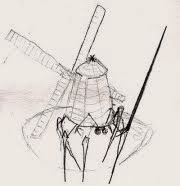Co-Operative Vs. Lockstep
Timing can be critical.
If the sensory pulse is used to clutch and unclutch the drivetrain, than in the interest of least effort and minimizing wear, the shifts should be done while the drivetrain is not under load. If the mainspring regulator is pulsatile rather than continous, then sensory switching can be done during the 'null' portion of each beat. Of course, this means that the senses will beat counterpoint to the 'muscles'.
The question: is it more elegant to use one system clock, and than a pair of divide-by-two mechanisms to generate the 'motor' clock and the 'sense' clock ; or should there be a alternating mechanism, so that one beat of the 'motor' clock triggers one beat of the 'sence' clock, which in turn triggers the 'motor' clock?
Co-Operative Vs. Lockstep : Phrased like this it sounds like Dogma rather than Craft.
skip to main |
skip to sidebar
About Me
Blog Archive
-
▼
2006
(31)
-
▼
March
(8)
- Connection hit a new low today - 4800 bps. No, I d...
- Searched 'Rod logic' and synonyms.... found a dep...
- Yesterday was the fifth anniversary of Mir's re-en...
- High point of my week;Discovering that in E1M8, af...
- Deregulating the sences...While at work - which en...
- Co-Operative Vs. LockstepTiming can be critical.If...
- It should be possible to;Use an electroplating rig...
- Clockwork RobotsI use 'Robot' rather than 'Automat...
-
▼
March
(8)


No comments:
Post a Comment